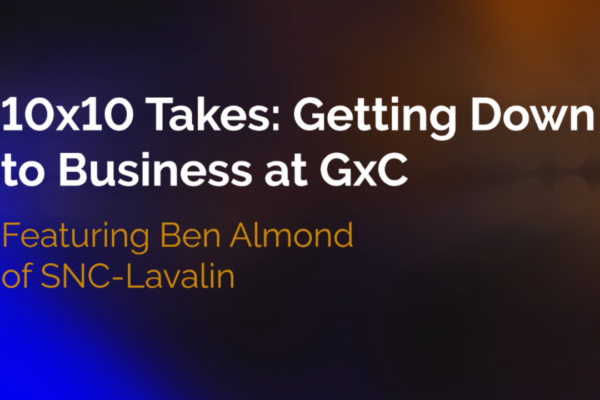In partnership with Junxion Strategy and the Social Purpose Institute at United Way
Introduction
At GLOBE Capital 2021 (April 13-15), participants joined the action-oriented GLOBE Advance sessions to help us go farther and faster to address risks and capitalize on opportunities in the clean economy. To propel the conversation, we’re pleased to share this summary of the GLOBE Advance session, Activating Social Finance: Advancing Purpose and Impact. This 2021 session built on the 2020 session GLOBE Advance: Turning Social Purpose Dialogue and Vision into Action, to inspire, inform, and help you explore how purpose pays.
The COVID-19 pandemic and a historic, global movement for racial justice have amplified a conversation that’s engaging corporate boards, C-suites, entrepreneurs, and investors around the world—the role of purpose in business. As we start the work of recovery, governments, corporations, entrepreneurs, and investors have the opportunity to reimagine our economy and their role in it.
Participants at GLOBE Advance: Activating Social Finance learned from businesses and investors operating at the intersection of profit and purpose, who are delivering financial returns and societal benefits. They considered new ways of valuing and measuring impact—from ‘E’, ‘S’ and ‘G’ perspectives. And they got the tools to go from defining, to measuring, to capitalizing on being a purpose-driven organization.
Activating Social Finance Speakers:
- Mike Rowlands, President and CEO, Junxion Strategy (Moderator)
- Sandra Odendahl, Vice President of Social Impact and Sustainability, Scotiabank
- David Redfern, President and CEO, Eastern Canada, Lafarge Canada Inc.
- Mary Ellen Schaafsma, Director, Social Purpose Institute at United Way
- Joel Solomon, Co-Founder, Renewal Funds
- Coro Strandberg, President, Strandberg Consulting
What is social purpose?
Larry Fink, CEO of Blackrock—has put his money behind social purpose. “To prosper over time, every company must not only deliver financial performance, but also show how it makes a positive contribution to society… Society is demanding that companies, both public and private, serve a social purpose,” Mr. Fink wrote in his widely quoted Annual Letter to CEOs.
How did ‘social purpose’ reach the desk of the world’s largest asset manager? To understand the importance of ‘social purpose’ today, it’s helpful to examine the roots of the movement.
‘Socially responsible investing’ or ‘SRI’ first started gaining traction in the 1980s. For the first time, investments looked beyond the financial bottom line to a goal of positive social impact. In the mid-90s, ‘corporate social responsibility’ began to catch on, a self-regulating business model that invited companies to be aware of and accountable for their economic, social, and environmental impacts. Increasingly, investors began to expect this level of accountability across their portfolios. This gave rise to ESG (environmental, social and governance) investing in the mid-2000s—a set of standards that investors use to screen potential investments, protecting themselves from risk and ensuring alignment with their values. ESG investing mandates companies to move beyond philanthropic portfolios to managing their environmental and social performance.
Eventually, about five years ago, ‘social purpose’ businesses started to take off. The Social Purpose Institute at United Way (SPI) defines a social purpose business as “a company whose enduring reason for being is to create a better world.” Social purpose has brought the social conversations that began in the 1980s into the C-suite. It’s no longer a line of business. Social purpose is a reason for doing business.
David Redfern, President and CEO, Eastern Canada, Lafarge Canada Inc., worked with SPI to develop a social purpose for Lafarge Western Canada (when he was the head of its Western operations). He found it helpful to think of purpose within existing business architecture:
- Purpose is why your business exists.
- Vision is where you want to go.
- Mission is how you want to get there.
- Values are what’s going to support it.
In working to define their social purpose, the Lafarge team took the opportunity to reflect on and refine the rest of its architecture as well. “The social purpose process made us more efficient, more aligned, and more engaged,” said Mr. Redfern.
Imagine how different our economy would be if every company embraced a social purpose. That’s what Mike Rowlands, President and CEO, Junxion Strategy, calls the ‘Next Economy’. “Social purpose isn’t an HR or PR exercise,” he said, “It’s an exercise in reshaping the role of business in society.”
In short, purpose pays
Companies that operate with a social purpose outperformed other companies by 134% in the stock market in 2019. This reinforces evidence from 2008, when researchers found B Corps—the leading certification for business as a force for good—were 64% more likely to survive the recession.
SPI Director Mary Ellen Schaafsma shared the success story of one social purpose company that applied a social purpose lens to its three-year strategic planning process. In doing so, the leadership discovered about 80% of their priorities did not align with their social purpose. By dropping these priorities, they opened up space for creativity and innovation.
Social purpose is also popular with the public and with employees. The majority of Canadian consumers (89%) believe business needs to place the same weight on society’s interests as on business interests and 60% of millennials want to work for companies with a purpose. Consumer trends and talent management are each drivers of business success—and therefore valuable to investors.
Joel Solomon can testify to the rise of investor interest in social purpose. He co-founded Renewal Funds, a venture capital firm that invests in innovation to advance the sustainability of food, water, and climate. He’s watched his firm’s invested assets grow to $250 million. “Social purpose is unstoppable,” Mr. Solomon said.
For those hesitant to act, there is a real risk in failing to adopt a purpose and being left behind. Mr. Redfern shared that this past financial year was successful for Lafarge and they expected to see their stock value increase. It didn’t. Why? Investors were concerned about the high carbon footprint of cement and were reluctant to invest further. “That reinforced for me the importance of having and acting on purpose,” said Mr. Redfern.
Ahead on the path to impact
With increasing evidence that adopting and implementing a social purpose is good business, how do we measure success?
When Sandra Odendahl joined Scotiabank in 2020 as the Vice President of Social Impact and Sustainability, she spent her first year examining the bank’s impact and identifying a social area to focus on that was consistent with the bank’s social purpose. She chose economic resilience and launched ScotiaRISE, a 10-year, $500 million initiative to promote economic resilience among disadvantaged groups.
To measure success for ScotiaRISE, the bank tracks very specific markers linked to its programming, including completion of high school and post-secondary training, increase in family income, and the number of black female entrepreneurs attracting investors, for example. In the diverse world of social purpose, these tailored measures provide the best gauge of Scotiabank’s success.
But what about a measurement that allows for comparison from one social-purpose business to another? Enter SPI’s new Social Purpose Assessment tool, launched at GLOBE Capital. The tool allows stakeholders to assess social purpose companies using 25 practices across seven different areas.
It’s encouraging to see innovation and growth in the social purpose space after a year when social inequalities were exposed like never before. “The COVID-19 crisis was a reckoning on social issues that have been papered over with spit and bubble gum for years,” said Ms. Odendahl. She cited guaranteed basic income, alternatives to long-term care for seniors, racism, and childcare as key issues that the pandemic has brought into stark relief.
However, Ms. Odendahl does see a new mindset in how business is responding to the pandemic, compared to how they responded to previous economic crises. “Our CEO recently made a recommendation to top up the Canada Child Benefit and massively increase the Canada Child Tax Credit, because providing greater flexibility to families is good for the country, for women, and for communities. I can’t imagine a CEO responding to the 2008 financial crisis in the same way.” (You can read more about Scotiabank CEO Brian Porter’s recommendation here.)
Ms. Strandberg agreed that the pandemic was an inflection point. “Now people are starting to say ‘let’s create the economy we want’ instead of the economy that grew by topsy,” she said. Ms. Strandberg sees the beginnings of a social purpose for finance—a trend with the potential to provide a new lens on investing that could even become a new asset class.
Mr. Solomon said next generations will push social purpose faster and further. “Tens of billions of dollars are being inherited in North America alone over the next few decades… Young investors are increasingly concerned about what money is doing in their name.”
With such exciting trends on the horizon, we look forward to continuing the conversation at Propelling Purpose: The Road to the Purposeful Economy (November 17-18, 2021) and at GLOBE Forum (March 2022).
Until then, we’d like to leave you with a challenge: What’s one commitment you can make to accelerate the movement to purpose-based business?




